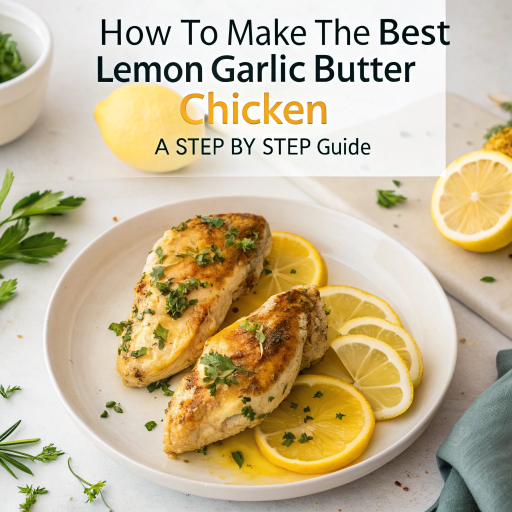If you’re looking for a delicious and easy-to-make dinner, look no further than lemon garlic butter chicken. This recipe combines the tangy brightness of lemon, the rich flavor of garlic, and the creamy goodness of butter to create a dish that’s sure to impress. Whether you’re a seasoned cook or a beginner in the kitchen, this step-by-step guide will help you create the perfect lemon garlic butter chicken. Let’s dive into the ingredients, preparation, and cooking techniques that will make this recipe a staple in your meal rotation.
Table of Contents
Ingredients for Lemon Garlic Butter Chicken

1. Chicken Breasts
Chicken breasts are a versatile and lean protein source, making them perfect for this recipe. Look for high-quality, organic chicken breasts to ensure the best flavor and texture. To prepare, trim any excess fat and pat the chicken dry with paper towels. If you prefer, you can also use chicken thighs or even a whole chicken cut into parts for this dish. Just be sure to adjust the cooking time accordingly.
2. Key Ingredients
The star of this dish is the combination of lemon, garlic, and butter. Fresh lemon juice and zest provide a tangy flavor that complements the savory garlic and rich butter. Use fresh garlic cloves for the best taste, either minced or thinly sliced. Unsalted butter is preferred to control the saltiness of the dish, but you can use salted butter if that’s what you have on hand. Olive oil is also used for sautéing, adding a subtle fruity flavor.
3. Seasonings
Seasoning is crucial to bring out the flavors of this dish. Start with the basics: salt and pepper. These enhance the natural flavors of the ingredients without overpowering them. For extra depth, you can add herbs like thyme or spices like paprika. These optional seasonings can elevate the dish and add complexity to the flavor profile. Experiment with different combinations to find what you like best.
Preparing the Lemon Garlic Butter Chicken
4. Marinating the Chicken
Marinating the chicken is an important step to infuse it with flavor and tenderize the meat. Create a simple marinade using lemon juice, minced garlic, olive oil, and herbs like thyme or rosemary. Place the chicken in a resealable plastic bag or a shallow dish, pour the marinade over it, and ensure all pieces are well-coated. Let the chicken marinate in the refrigerator for at least 30 minutes, or up to 4 hours for a more intense flavor.
5. Preparing the Lemon Garlic Sauce
The lemon garlic sauce is the heart of this recipe, providing the rich and tangy flavor that makes the dish stand out. To make the sauce, you’ll need lemon juice, lemon zest, minced garlic, and unsalted butter. In a small bowl, combine the lemon juice and zest with the minced garlic. This mixture will be added to the pan during cooking to create a fragrant and flavorful sauce. The butter will be melted in the pan to form the base of the sauce, adding creaminess and depth.
Cooking Techniques
6. Pan-Searing the Chicken
Pan-searing the chicken is the first step in cooking it to perfection. Heat a large skillet over medium-high heat and add a tablespoon of olive oil. Once the oil is hot, add the marinated chicken breasts to the pan. Cook for 4-5 minutes on each side, or until the chicken is golden brown and cooked through. This technique helps to lock in the juices and create a flavorful crust on the chicken. Be sure not to overcrowd the pan; cook the chicken in batches if necessary.
7. Making the Lemon Garlic Butter Sauce
After pan-searing the chicken, it’s time to make the lemon garlic butter sauce. Reduce the heat to medium and add the minced garlic to the pan. Sauté for 1-2 minutes until fragrant, being careful not to burn the garlic. Add the lemon juice and zest mixture to the pan, stirring to combine. Finally, add the unsalted butter and let it melt, creating a rich and creamy sauce. Return the chicken to the pan, spooning the sauce over the top to coat it thoroughly.
8. Baking the Chicken

For an extra layer of flavor and tenderness, you can finish cooking the chicken in the oven. Preheat your oven to 375°F (190°C). After making the lemon garlic butter sauce, transfer the skillet to the oven and bake for 10-15 minutes, or until the chicken is fully cooked and reaches an internal temperature of 165°F (74°C). This step ensures the chicken is cooked evenly and absorbs all the delicious flavors of the sauce.
Serving Suggestions
9. Pairing with Sides
The lemon garlic butter chicken pairs wonderfully with a variety of side dishes that complement its rich and tangy flavors. Consider serving it with creamy mashed potatoes, which soak up the delicious sauce beautifully. Steamed vegetables, such as broccoli, green beans, or asparagus, add a fresh and crunchy contrast. For a lighter option, a simple mixed green salad with a lemon vinaigrette can balance out the richness of the chicken.
10. Garnishing the Dish
Garnishing your dish not only enhances its visual appeal but also adds extra layers of flavor. A sprinkle of fresh parsley or chives can bring a pop of color and a fresh taste to the chicken. Lemon wedges on the side provide a bright, citrusy boost that diners can squeeze over their chicken for extra zing. You can also add a touch of grated Parmesan cheese for a slight umami kick, elevating the overall presentation and taste of the dish.
11. Storing and Reheating
If you have leftovers, proper storage is essential to maintain the dish’s quality. Place the cooled chicken and sauce in an airtight container and refrigerate for up to 3 days. When reheating, use a low heat setting to prevent the chicken from drying out. You can reheat the chicken in a microwave, on the stovetop, or in the oven. If the sauce thickens too much during reheating, add a splash of chicken broth or water to bring it back to the desired consistency.
Additional Tips and Variations

12. Adjusting for Dietary Preferences
This lemon garlic butter chicken recipe can be easily adapted to meet different dietary needs. For a dairy-free version, replace the butter with a dairy-free alternative such as coconut oil or a vegan butter substitute. To make the dish lower in fat, you can use a smaller amount of butter or opt for a butter-flavored cooking spray. The recipe is naturally gluten-free, but always double-check ingredient labels to ensure all components are free from gluten.
13. Flavor Variations
Experimenting with different flavors can keep this recipe exciting every time you make it. Add a touch of heat by incorporating red pepper flakes or a dash of hot sauce. For a Mediterranean twist, mix in some olives, sun-dried tomatoes, and capers. You can also introduce vegetables like cherry tomatoes, spinach, or bell peppers into the dish for added texture and nutrition. These variations allow you to customize the recipe to your taste preferences and make it a staple in your meal rotation.
14. FAQs and Troubleshooting
- Why is my chicken dry? Ensure you are not overcooking the chicken. Use a meat thermometer to check for an internal temperature of 165°F (74°C).
- How can I make the sauce thicker? If the sauce is too thin, let it simmer for a few extra minutes to reduce and thicken. Alternatively, mix a teaspoon of cornstarch with water and stir it into the sauce.
- Can I use bone-in chicken? Yes, but you will need to adjust the cooking time accordingly. Bone-in chicken pieces generally require a longer cooking time.
Conclusion
Recap the main points of the article, encouraging readers to try the recipe and enjoy the process of cooking. Emphasize the importance of experimenting with flavors and making the recipe their own. Invite readers to share their experiences, variations, and any questions in the comments section. Encourage them to continue exploring and enjoying their culinary journey with more delicious recipes.
FAQs for Lemon Garlic Butter Chicken Recipe
Can I use chicken thighs instead of chicken breasts?
Yes, you can substitute chicken thighs for chicken breasts. Thighs tend to be juicier and more flavorful but may require slightly longer cooking times. Always ensure the internal temperature reaches 165°F (74°C).
What can I do if my sauce is too thin?
If the sauce is too thin, allow it to simmer for a few minutes to reduce and thicken. Alternatively, mix a teaspoon of cornstarch with a tablespoon of water and stir it into the sauce.
Can I make this recipe dairy-free?
Absolutely! Replace the butter with a dairy-free alternative, such as coconut oil or vegan butter, for a dairy-free version of this dish.
How do I prevent the chicken from becoming dry?
To avoid dryness, don’t overcook the chicken. Use a meat thermometer to check the internal temperature, which should reach 165°F (74°C). If you’re finishing the chicken in the oven, keep an eye on the timer to avoid overbaking.
Can I use bottled lemon juice instead of fresh lemons?
While fresh lemon juice is recommended for the best flavor, bottled lemon juice can be used in a pinch. Just note that the taste may be less vibrant.
How can I store leftovers?
Place leftover chicken and sauce in an airtight container and refrigerate for up to 3 days. When reheating, use low heat and add a splash of chicken broth or water to keep the sauce from drying out.
Can I make this recipe gluten-free?
This recipe is naturally gluten-free. However, if you’re adding any additional ingredients like broth, ensure they are certified gluten-free by checking the labels.
Can I make this dish ahead of time?
Yes, you can prepare the marinade and sauce components in advance. Store them separately in the refrigerator. Cook the chicken and combine it with the sauce just before serving for the freshest taste.
What sides go best with lemon garlic butter chicken?
This dish pairs wonderfully with mashed potatoes, rice, or crusty bread to soak up the sauce. Steamed or roasted vegetables like broccoli, green beans, or asparagus also make great accompaniments.
Can I use chicken thighs instead of chicken breasts?
To elevate the flavor, consider adding herbs like rosemary or thyme to the marinade or sauce. You can also incorporate red pepper flakes for a touch of heat or stir in some Parmesan cheese for an umami boost.
Can I cook this recipe without finishing it in the oven?
Yes, if you prefer stovetop-only cooking, you can simmer the chicken in the sauce over medium heat until it is fully cooked. Just ensure the internal temperature reaches 165°F (74°C).
Can I freeze the cooked chicken?
Yes, you can freeze the cooked chicken along with the sauce. Allow it to cool completely, then transfer it to a freezer-safe container or bag. Freeze for up to 3 months. Thaw in the refrigerator overnight before reheating.
Why did my garlic burn during cooking?
Garlic burns easily at high heat. To avoid this, lower the heat before adding garlic to the pan, and stir it frequently. Be careful to sauté it just until fragrant and golden.
Can I make this recipe in a slow cooker?
Yes, you can adapt this recipe for a slow cooker. Sear the chicken first, then place it in the slow cooker with the sauce ingredients. Cook on low for 4-6 hours or on high for 2-3 hours, until the chicken is tender and fully cooked.

